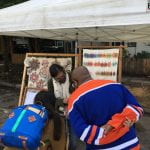Greetings from Interim Director
After another unpredictable year, we at Oregon Folklife Network are grateful for the generous support that keeps our doors open. The COVID-19 pandemic has been especially devastating to folk and traditional arts. Artists lost essential income as craft inventories waned with supply chains, and performance venues closed or limited operations. Traditional practices that thrive in community remain threatened by isolation and loss of culture bearers, individuals who have been pillars in their community’s cultural vitality.
During this time of extreme need among our constituents, OFN’s doors stay open to serve. Despite downsizing operations, we increased our funding opportunities for artists and administered a new series for master artists to share their traditions and stories with audiences hungry for interaction. Linking arms with institutional partners, OFN reached across the state to maintain satellite offices in Bend and Ontario, mentoring local organizations in the Willamette Valley and Coast who innovated to safely bring audiences together and provide critical funds to artists and their communities.
- Patti Jo Meshnik, demonstrates Norwegian Rosemåling. Photo by Whiteaker Community Market, Eugene
- Diana Gaspar-Sanchez, shows Zapotec Beading. Photo by Whiteaker Community Market, Eugene
- Nirmala Waterhouse, shares Paraguayan Ñandutí Lace. Photo by Whiteaker Community Market, Eugene
- Traditional weaver, Wenix Red Elk (Umatilla) teaches a weaving workshop. Photo by Columbia River Maritime Museum, Astoria
Traditional practices and expressions have survived generations of change and upheaval because they are dynamic, integral, and treasured. Traditional artists are community role models of resiliency, actively expressing their cultural past in the present moment where time-honored wisdom comforts and helps during hardship. Across Oregon’s many cultural communities and Tribes, one modest value connects them all: to do good work in a good way. We at OFN invite you to commit to that value in 2022, and help us support the exceptional traditional arts practiced in exceptionally courageous ways in every part of Oregon.
Your donation to OFN directly supports the work of traditional artists in Oregon communities and Tribes. Every gift is a commitment to the cultural vitality of Oregon.
All donations are tax-deductible and you can double your gifts for free by making a matching gift to the Cultural Trust and claiming your cultural tax credit! Will you make a gift to help Oregon’s cultural communities thrive? Any amount, whether it be a one-time gift or a monthly donation, will help us meet our goal of $5,000 before the end of the year.
From the entire OFN family, thank you for your interest in what we do.
Sincerely,
Emily West Hartlerode
Interim Director










